I Iive with my partner in a terraced house in London, and we have a garden. So we have to work out what we want the garden for. Do we want to use it to impress people, to give it a ‘make-over’, to make it orderly and tidy, or to produce food? We’ve decided that mostly, we want to use it to let nature have a place in the city. We’ve put in a couple of fruit trees, plus blackcurrant and gooseberry bushes, strawberries, rhubarb, some greens and some herbs – but that’s for fun rather than sustenance. For us, the garden is mostly for inviting nature in, and hanging out in it. It’s easy because it’s a reasonably lazy option. Not as lazy as concrete slabs or decking, but the result is prettier and better for ecology.
Producing food was the other option that we both thought was an apt thing to do with a garden, but as she’s an overworked NHS consultant and I spend most of my time building the Lowimpact website and trying to work out how to get to a sustainable, non-corporate system, neither of us has the time to do it very efficiently – unlike the people in the video below, who are heroes.
But the other options didn’t really do it for us. We don’t want ‘style’ in the garden, when nature can do it much better. And that means not being too zealous in getting rid of weeds (apart from bindweed, which would just take over completely, given half a chance). But we’ve left a couple of clumps of nettles, because it’s the food plant of the three most beautiful butterflies in the UK (possibly) – the Tortoiseshell, Peacock and Red Admiral, (in that order) below.



And we really, really didn’t want any plastic, metal, poisonous chemicals or concrete in the garden – which meant digging tonnes out. Clearly previous owners didn’t feel the same way, as we ended up filling a small skip with concrete from the front and back gardens. I got a pick-axe from the garden centre and was put to work. Getting rid of the concrete felt symbolic and cathartic. In miniature, it was what I’d like to see happen to the whole earth – remove as much concrete as possible, ban poisonous chemicals and let nature come back. Sorry if that sounds a bit too hippie for you, but that’s how it felt.

I’ll blog more about front gardens later – more and more of them are being covered in slabs so that cars can be parked on them, often to escape charges for parking on the road. But for the moment, let’s concentrate on back gardens, where this isn’t the case. Still, lots of people lean towards removing as much nature as they can, and banishing it from their little patch of the great outdoors, by replacing it with concrete, paving slabs, decking, or, as with two ‘gardens’ we can see from our bedroom window – astroturf. What’s that about? One of the astroturfers even asked our next-door neighbour if he’d like help to remove the ash trees that have grown like weeds in a little space between properties at the ends of our gardens, ‘because they block the light’ (they really don’t). Luckily, he didn’t. That little grove of trees was one of the main reasons we moved here.
Practicalities – including a few questions
We’ve set up a compost system that will use our kitchen and garden waste to improve the soil, and planted a holly bush in front of them, as they’re not super-attractive (holly takes a long time to grow though, so we’ll be seeing them for a while).

I planted grass seeds and wild flower seeds where the concrete slabs used to be either side of the lawn – just packets from a local garden centre. We now have a grass meadow, but not a wild flower meadow, as no wild flowers came up. Any ideas what I did wrong? I planted some in March and some in June, and did exactly what it said on the packet – but nada.
Where the concrete pad at the end used to be we’re going to build a pond and put some tadpoles in – see if we can invite some frogs into the garden to eat pests. We saw a dragonfly in the garden recently, so there must be larvae living in ponds near to us. I intend to build the pond by puddling clay. Anyone tried that?
We want to keep a small area of lawn, and I’m thinking I might get a scythe (no electricity, no noise, good exercise). I asked Simon Fairlie if he thought that was mad and he sent the pic below. So no, not mad. I have an idea that I’d like to hang the scythe on the wall, inside, next to the patio doors, and amazingly, the mrs. (who wants to remain anonymous) didn’t seem to mind. I just want to see visitors expressions – and it’s a handy place to keep it.

Also in the lawn, we’d like to encourage clover or daisies. At the moment, there’s nothing at all in the lawn except grass – anyone got any ideas?
I’ve planted ivy along the base of the back fence – some recently and some several months ago. None of it seems to have grown at all though, let alone look as though it might cover the fence any time soon. Anyone got any tips on getting ivy to get a move on?
We’ve got stag beetles. Are they unusual in urban gardens?
We’ve let a little hazel shoot grow, and now it’s almost 6 feet tall. Do you think we’ll ever get any hazelnuts from it, or do we have no chance of keeping them from London squirrels?



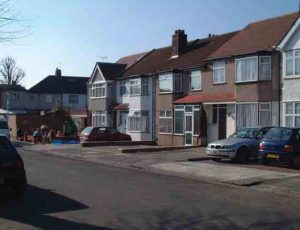
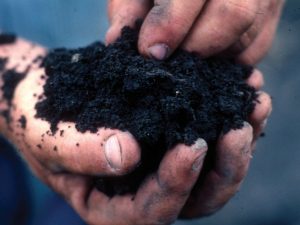
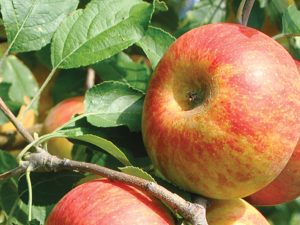
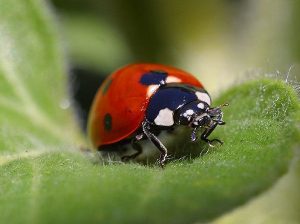
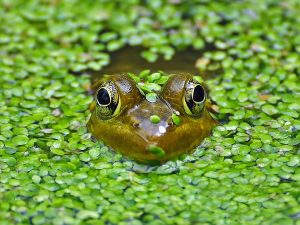
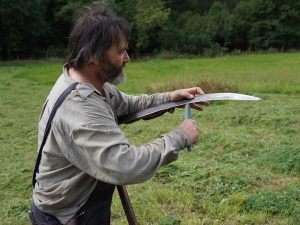
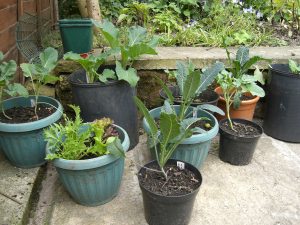
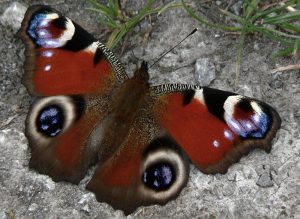

5 Comments
You have a fantastic amount of space for your garden, and it looks like it catches a lot of sun. I’m sure whatever you try to grow will do very well.
If you’re near east London I recommend a visit to Tower Hamlets Cemetery Park*. Many years ago I was a conservation volunteer and helped to clear an area and create a wildflower meadow and pond (I think it’s called Scrapyard Meadow). I think it took a year or so to properly establish.
My understanding is that some seeds need the coldness of winter before they start to germinate, also depending on the seed mixtures some get a chance to grow when others in the mix have died down a little.
You mention you have nettles in your garden too – do these add too much nutrient to the soil? Wildflowers grow well in low-nutrient ground. I don’t know if the nettles are affecting the wildflower growth, perhaps not.
I’m involved with my local transition group and we have planted some wildflower seeds under the shade of a magnolia tree and along the edge of our food growing area. Some plants have already come through and I hope these patches will develop more over time. I’m planning to collect some seed heads from nearby open spaces towards the end of summer and adding to our wildflower area.
As for stag beetles London, particularly south, is a haven for them. Despite all the stag beetle loggeries I helped create as a volunteer, I haven’t seen a single stag beetle.
*I have a few photos of the meadow but they’re not good quality:
https://www.flickr.com/photos/saira_b/2689863585
https://www.flickr.com/photos/saira_b/2690598976
https://www.flickr.com/photos/saira_b/2689863549
https://www.flickr.com/photos/saira_b/2690598962
Hi Saira – ah, maybe that’s it – maybe we’ll get wild flowers next year.
Plus we’re in south London, so stag beetles not so rare then. I’ve seen one flying in our garden – it really doesn’t seem physically possible, but they do it, in a clumsy way. Magnificent looking things.
It might be worth doing a soil test on different parts of your garden to see if it acid or akaline. Also wild flowers do not like nutrient rich soil although there are, obviously, different types. The pond is a good idea but until you have a wild bit with slugs and other prey I don’t know what the frogs will feed on. Try reading the low impact blog on natural pest control, it has a bit there about frogs. Also reading a bit about permaculture in general might help. Wish we had stag beetles.
Hi. Here’s the garden two years later – http://www.lowimpact.org/wp-content/uploads/IMG_1098.jpg. We’ve got quite a few wild bits – long grass with wild flowers, ivy, ferns, and a patch that’s completely wild, with nettles for catterpillars. We’ve planted a holly bush, rhubarb, blackcurrants, strawberries, gooseberries, an apple and cherry tree. The hazel tree is 12ft tall now. The pond is a maybe, but we’ve planted a living willow fedge across the garden, and we’ll weave in the extra growth in the winter. We got the concrete out of the front garden and planted fruit bushes, strawberries and an apple tree (but at the same time, our neighbour concreted his garden to park his BMW. You win some, you lose some).
And still haven’t got the scythe, but it’s on the to do list.